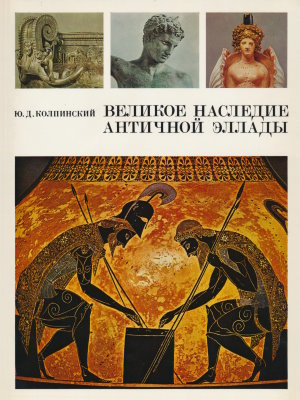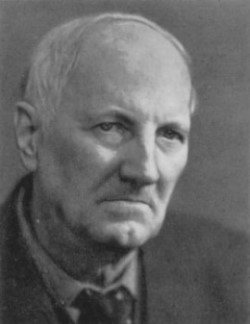 Ю.Д. Колпинский
Ю.Д. Колпинский
Великое наследие античной Эллады
и его значение для современности.
// М.: «Изобразительное искусство». 1977. 344 с.
См. текст на сайте СНО.
См. также 2-е издание.
[ аннотация: ]
Великое наследие античной Эллады рассматривается в перспективе исторического развития, в свете проблем культуры социализма. Автор отбирает основные, наиболее значительные памятники архитектуры, скульптуры, живописи, керамики и, характеризуя их, выявляет достоинства, существенно важные не только для данного этапа греческого искусства, но и для искусства последующих эпох.
Увлекательное, эмоциональное изложение сложных вопросов, красочный язык, обширный иллюстративный материал делают эту книгу интересной не только для специалистов, но и для широкого круга читателей.
Оглавление
Введение. — 5
Часть I.
Глава I. Общая характеристика культуры античной Эллады. — 9
Глава II. Античное мировоззрение и общие черты античной художественной культуры. — 16
Глава III. Роль мифологического начала в художественной культуре античной Эллады. — 20
Глава IV. Античные традиции в последующей истории художественной культуры. — 29
Часть II.
Раздел первый.
Доархаическое, или протополисное искусство. — 42
Раздел второй.
Искусство эпохи сложения, расцвета и кризиса греческого рабовладельческого полиса. — 56
Глава I. Искусство архаики. — 58
Глава II. Искусство ранней и зрелой классики. — 87
Глава III. Искусство поздней классики. — 130
Resume. — 150
Список иллюстраций. — 151
Иллюстрации [1-369]. — 161
Resume. ^
The heritage of Ancient Hellas went down in history as an exceedingly important phenomenon. Many cultures both in Europe and Asia leaned to a certain extent on the heritage of ancient Greek art. The great cultures inspired by the pathos of humanism, realism and the heroic feeling of the duty of Man turned to it especially often. The Renaissance and the classicism of Enlightenment of the 18th century are the most notable and well-known examples to it. Many other artistic trends endeavoured to use it, appealing to it and falsifying it. Among them were the artistic trends which preached abstruse approach to reality, and also some trends in bourgeois art of the time of its decline (Nietzsche and others).
The study of ancient art has always been closely linked with the fight of the progressive and the reactionary trends in social and artistic theories of the 19th and the 20th centuries. The assertion of the great value of ancient art, the fight against the distortion of its real nature or deliberate derogation is one of the essential facets of the ideological and artistic fight in contemporary world. Therefore, it’s only natural that Soviet art critics should constantly turn to the study of antiquity. In this work the author takes up the following aspects of the study of Ancient Greece, the aspects which are closely related to each other:
1. A determination of the historical conditions for the appearance of artistic culture, the place of this culture in the spiritual and social practice of ancient society.
2. A determination of those unique artistic values which Ancient Greece contributed to the world culture, and which still remain the objects of our aesthetic enjoyment.
3. Their influence on the further history of culture, their role of a tradition, which Socialist artistic culture turns to and strives to imbibe. Since in the study of the real artistic process these aspects turn out to be closely linked, they are not singled out each into a special chapter, but serve as the three main clues on which the research is centered.
A ramified, though integral system of the types of art was created first by the early class civilisations in the Middle East, the Far East, the Indian sub-continent, the cultures of ancient America (which still await a full study) and by the ancient Mediterranean cultures. It was for the first time, that the great potentialities of the artistic, image-bearing reflection and cognition of reality and the world around sprang up to life. They appeared there, though they were still linked with the element of mythological thinking and the religious cult, but they were the fruit of the artistic and creative nature of social consciousness.
A lofty idea of the ethical and aesthetic value of man, an organic unity of the personal and the social, the concrete sensuality of an image and its general significance, are expressed in ancient art with utmost clarity, as is the plastic and the inner completeness of the embodiment of the artistic ideas of those times.
Ancient art was a product of concrete social-historical conditions which were overwhelmed in the further historical development of society. In its controversial, uneven artistic progress, society gave birth to new values, which were no less significant. But these appeared at the price of the loss of the ability to create artistically certain images and artistic ideals, which, created by the specific conditions of the development of ancient society, expressed concrete valuable aesthetic needs. The importance of these needs is felt especially keenly in the epoch of socialism.
The book analyses the process of the uneven artistic development born by the spontaneous and controversial progress of society at the stage of its class-exploitation evolution. Is also stresses that at the period of the transition of society to the classless stage, the ability for and all-round harmonious development of the aesthetic needs of human society and of individual man is gradually realised in artistic culture, this ability being inherent in the nature of communism. Hence, a chance for a really universal cognition and imbibing of the whole wealth of the aesthetic heritage of the past, performed from the position of humanism, realism and national character.
The way in which the author approached the problem dictated a necessity for such a type of research, which calls for certain difficulties at its realisation. This work is not related to the theory of art only. Neither is it a pure work on the history of art. This is an attempt at creating a work of the "historical-theoretical" or "theoretical-historical" character. Works of this type are, in some measure, advantageous. Though the y are apt to lose some of the potentialities inherent in a purely theoretical or historical artistic work, a certain confluence and inter-enrichment of both the approaches is achieved. The character of the problems studied determines the work’s composition.
In its first part the author takes up the conditions for the formation of the artistic culture of Ancient Greece. The period of its heyday is described, a general characteristic of its values is given alongside with the analysis of the destiny of its heritage in the epochs to come, and the attitude of socialist culture to it.
The second part is devoted to the study of the principal stages of the historical development of Ancient Greece. Their aesthetic contribution is discussed both from the point of view of revealing their unique peculiarity and from the point of view of their being an indispensable link in the process of the evolution of ancient and world art.
The author does not claim to an exhaustive analysis of the historical-artistic material. At the same time he endeavours, in the second part especially, to reveal the historical logic of the artistic process. By a detailed analysis of the most notable monuments he hopes to be able to disclose the unique artistic charm of Greek art, and its value for the spiritual-aesthetic development of Soviet people.

(Открыть фото в новом окне)
^ [ на клапанах суперобложки: ]
Юрий Дмитриевич Колпинский (1909-1976), член-корреспондент Академии художеств СССР, заслуженный деятель искусств РСФСР, доктор искусствоведения, профессор, был крупным учёным, глубоким знатоком искусства, блестящим лектором, воспитавшим несколько поколений молодых искусствоведов.
Ещё в 1930-е годы вышли его первые книги — об искусстве Древней Греции и эпохи Возрождения, в которых молодой ученый утверждал высокую ценность классического наследия, значение великих традиций мирового реалистического искусства. В дальнейшем всю свою плодотворную научную и педагогическую деятельность Ю.Д. Колпинский посвятил разработке принципов марксистско-ленинской эстетики применительно к истории и современной практике художественного творчества.
Учёный широкого диапазона, он участвовал в создании обобщающих научных трудов по марксистско-ленинской эстетике, возглавлял капитальные многотомные издания по истории мирового изобразительного искусства («Всеобщая история искусств», «Памятники мирового искусства»), писал монографии о крупнейших советских скульпторах, откликался в многочисленных статьях на актуальные проблемы искусства социалистического реализма и боролся против различных форм модернизма.
Талантливый педагог, он тонко чувствовал и глубоко понимал искусство и захватывал слушателей блестящим анализом художественных произведений, широтой обобщений и выводов. В течение многих лет он читал лекции на искусствоведческом отделении Московского государственного университета, в Московском художественном институте имени В.И. Сурикова. Он успешно проявил свои знания, свой талант на работе в Научно-исследовательском институте теории и истории изобразительных искусств Академии художеств СССР. За активное участие в создании «Всеобщей истории искусств» Ю.Д. Колпинскому была присуждена золотая медаль Академии художеств СССР.
В последние годы жизни им были завершены многолетний труд «Великое наследие античной Эллады и его значение для современности», а также исследование «Искусство этрусков и Древнего Рима».
Yuri Dmitrievich Kolpinsky (1909-1976), an Associate-Member of the USSR Academy of Arts, Hounoured [Honoured] Art Worker of the RSFSR, Doctor in Art Criticism, and professor was a prominent scientist, an outstanding art connoisseur and a brilliant lecturer who educated several generations of young art critics. His first books appeared yet in the 1930s. Those were books on the art of Ancient Greece and the Renaissance. In them the young scientist asserted the unparalleled value of the classical heritage, the significance of the great traditions of the world realistic art. His further fruitful activities in science and education were devoted to the development of the principles of Marxist-Leninist aesthetics in its application to both art creation at present and its history.
A scientist whose scope of knowledge was very broad, he took part in the creation of fundamental scientific works on Marxist-Leninist aesthetics, such as the “General History of Arts” and “Monuments of World Art”. He wrote monographs on the eminent Soviet sculptors and published a great number of articles in which his views on the acute problems of Socialist realism were stated. He was also an active fighter against various forms of Modernism.
His understanding of art was exceedingly subtle, and as a talented educator, he easily won his listeners’ attention by his brilliant analysis of artistic works and by the breadth of his generalisation and conclusions. A professor at the Department of Art Criticism at Moscow State University and Moscow V.I.Sourikov Arts School, he lectured there for many years.
He used his talent and knowledge, working at the Scientific-Research Institute of the Theory and History of Imitative Arts of the USSR Academy of Arts.
Yuri Dmitrievich Kolpinsky was awarded a gold medal of the USSR Academy of Arts for his active participation in the creation of the “General History of Arts”. In his last years he completed the “Great Heritage of Ancient Hellas and Its Significance for the Present”, a work of many years, and a fundamental research work entitled “The Art of Etruscans and Ancient Rome”.
|